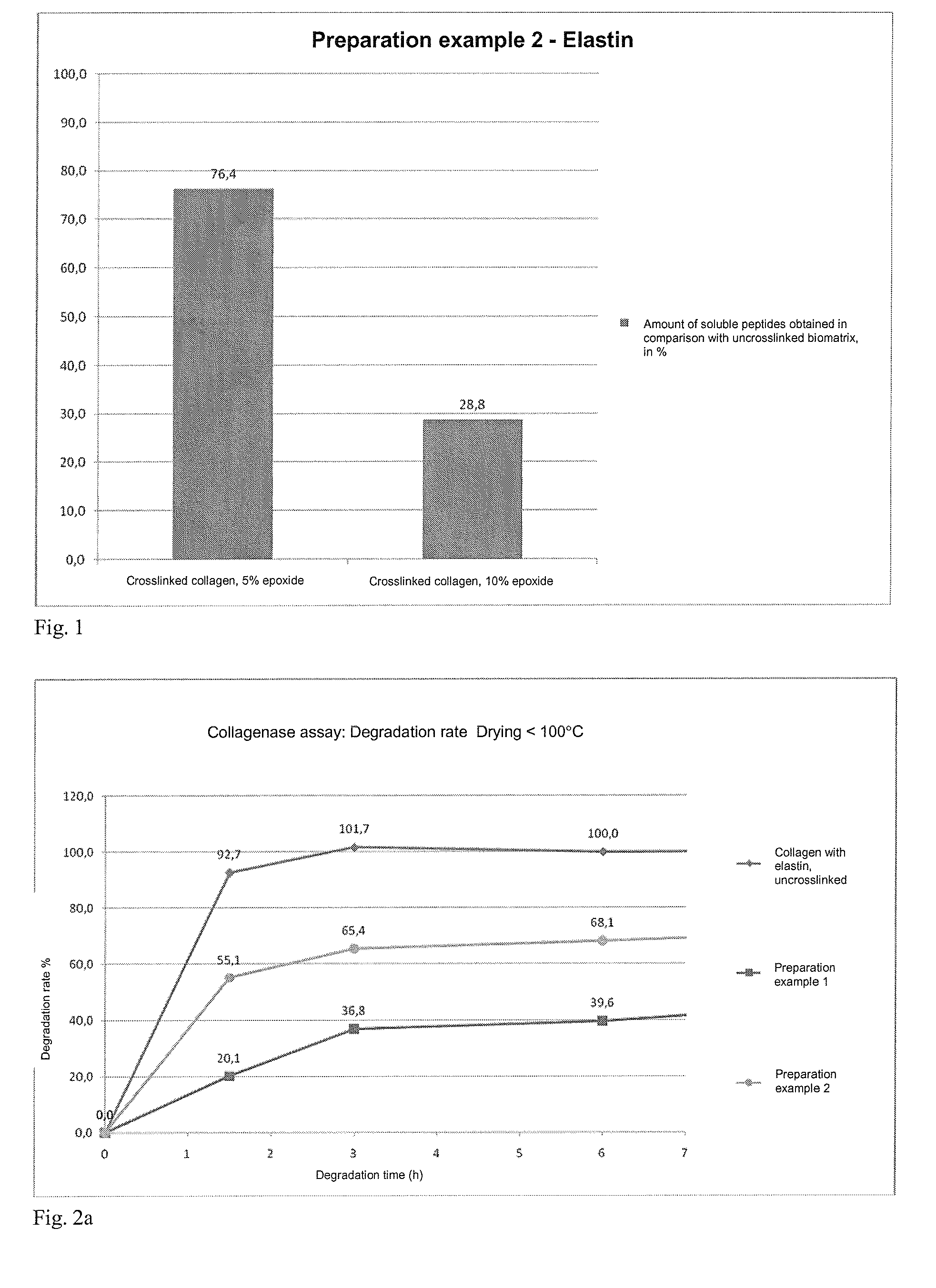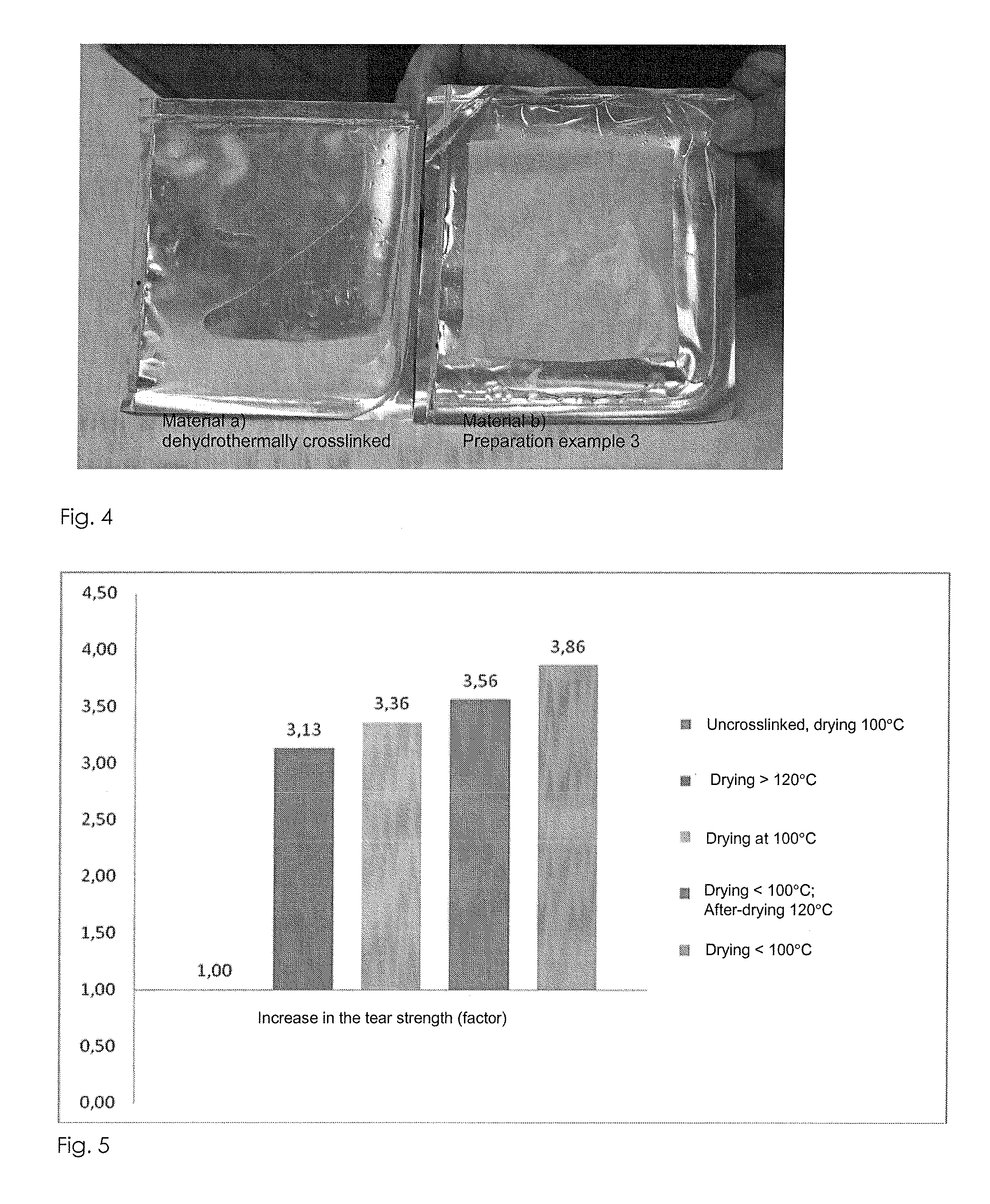Degradation-Stabilised, Biocompatible Collagen Matrices
a biocompatible, collagen-stabilised technology, applied in the direction of peptides, prosthesis, drug compositions, etc., can solve the problems of high time expenditure, undesirable change in material, shrinkage of layered material,
- Summary
- Abstract
- Description
- Claims
- Application Information
AI Technical Summary
Benefits of technology
Problems solved by technology
Method used
Image
Examples
example 1
Preparation Example 1a
Pure Collagen Matrix with Epoxide Crosslinking
5% Epoxide Crosslinking Agent / Dry Mass
[0186]Example for the preparation of an epoxy-crosslinked collagen biomatrix according to the invention without addition of further soluble protein or peptide constituents, active ingredients and / or auxiliary substances, using an amount of epoxide crosslinking agent of 5%, based on the dry mass of the collagen suspension.[0187]a) Provision of 3000 g of a collagen suspension (dry content collagen: 1.6%, collagen content: 48 g), prepared by the process according to DE4048622 A1 and in particular DE 10350654 A1.[0188]b) Adjustment of the pH value of the collagen suspension to pH 3.3.[0189]c) (omitted)[0190]d) At a temperature below 10° C., 2.4 g of 1,4-butanediol diglycidyl ether (BDDGE, Sigma-Aldrich) are added dropwise to the collagen suspension within a period of 5 minutes, while stirring with a paddle stirrer (eurostar, IKA) at 600 rps. The resulting mass is degassed in a vacuu...
preparation example 1b
Pure Collagen Matrix with Epoxide Crosslinking
10% Epoxide Crosslinking Agent / Dry Mass
[0195]Example for the preparation of an epoxy-crosslinked collagen biomatrix according to the invention without addition of further soluble protein or peptide constituents, active ingredients and / or auxiliary substances, using an amount of epoxide crosslinking agent of 10%, based on the dry mass of the collagen suspension.
[0196]The preparation is carried out analogously to Preparation example 1a, wherein in step d) 4.8 g of 1,4-butanediol diglycidyl ether (BDDGE, Sigma-Aldrich) are added and in step g) the re-hydration is carried out for up to 96 hours.
example 2
Preparation Example 2a
Epoxide-Crosslinked Collagen Matrix with Additional Soluble Protein Constituents from the Group of the Matrix Proteins (Elastin Hydrolysate)
5% Epoxide Crosslinking Agent / Dry Mass
[0197]Example for the preparation of an epoxy-crosslinked collagen biomatrix according to the invention with addition of further soluble protein / peptide constituents (matrix proteins: elastin) using an amount of epoxide crosslinking agent of 5%, based on the dry mass of the aqueous collagen suspension.[0198]a) Provision of 3000 g of a collagen suspension (dry content collagen: 1.6%, collagen content: 48 g), prepared by the process according to DE 4048622 A1 and in particular DE 10350654 A1.[0199]b) Adjustment of the pH value of the collagen suspension to pH 3.3.[0200]c) At a temperature below 10° C., 2.4 g of 1,4-butanediol diglycidyl ether (BDDGE, Sigma-Aldrich) are added dropwise to the collagen suspension within a period of 5 minutes, while stirring with a paddle stirrer (eurostar, I...
PUM
| Property | Measurement | Unit |
|---|---|---|
| temperature | aaaaa | aaaaa |
| reaction time | aaaaa | aaaaa |
| temperatures | aaaaa | aaaaa |
Abstract
Description
Claims
Application Information
 Login to View More
Login to View More - R&D
- Intellectual Property
- Life Sciences
- Materials
- Tech Scout
- Unparalleled Data Quality
- Higher Quality Content
- 60% Fewer Hallucinations
Browse by: Latest US Patents, China's latest patents, Technical Efficacy Thesaurus, Application Domain, Technology Topic, Popular Technical Reports.
© 2025 PatSnap. All rights reserved.Legal|Privacy policy|Modern Slavery Act Transparency Statement|Sitemap|About US| Contact US: help@patsnap.com



